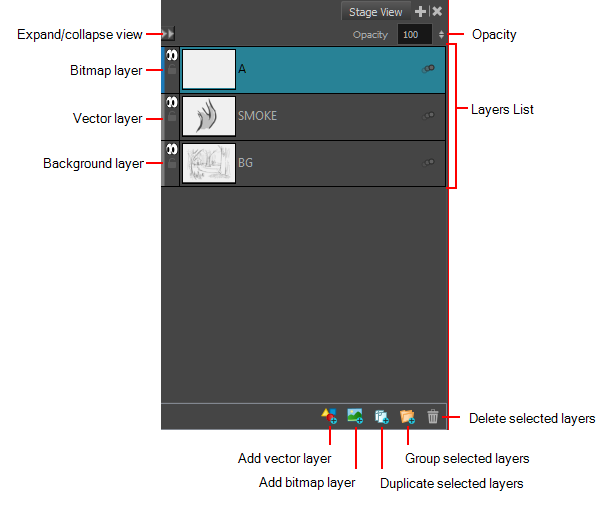Camera View
If you switch to the Camera view to preview the scene, the perspective is from the camera lens, so you can see exactly what the camera captures as it moves from one keyframe to another.
The status bar is located at the bottom of the Stage and Camera views and is displayed by default. The status bar contains shortcuts to tools used most often during the animatic stage of the storyboarding process.


- In a view area, click the Add View
 button and select Camera.
button and select Camera.
| Tool Name | Icon | Description |
|
Grid |
|
Displays a grid in the Stage and Camera views. The default size is the standard 12-field animation grid, but you can choose another. You can also select View > Grid > Show Grid or press Ctrl + G (Windows) or ⌘ + G (Mac OS X) |
|
Safe Area |
|
Shows or hides the TV safety zone and the centre of the camera frame. The safe area adapts to the scene resolution, as well as the safety zone and frame’s centre. You can also access this feature from the top menu by selecting View > Extras > Show Safe Area. You can define your own safety limits in the Preferences dialog box |
| Safe Area Mask |
|
Option of Camera and Stage views to turn on a gray layer showing TV safe area while viewing boards. NOTE: You can create a keyboard shortcut for showing the Action and Title Safe Areas masks.
|
|
4:3 Safety |
|
Shows or hides the TV safety zone and the centre of the camera frame for a regular 4:3 resolution. If you are working on a widescreen project, for example, you can easily plan in advance the conversion of your project to a TV format. This way, you can create your project to fit both resolutions. You can also select View > Extras > Show 4:3 Safe Area. |
|
4:3 Area |
|
Shows or hides the 4:3 resolution zone without the centre of the camera frame and TV safety zone. You can also select View > Extras > Show 4:3 Area. |
|
Camera Mask |
|
Shows or hides a black mask around the scene’s frame to avoid seeing anything outside the Camera frame. This is handy when you are setting up the scene as it allows you to see the scene’s composition better. You can also select View > Extras > Camera Mask. |
|
Reset View |
|
Resets any panning, zooming or rotation done in the Stage view and returns the display to its initial settings. You can also select View > Reset View or press Shift + M. NOTE: This option works with the Camera View.
|
|
Reset Rotation |
|
Resets any rotation done in the Stage or Camera view and returns the display to its initial rotation settings. You can also select View > Reset Rotation or press Shift + X. |
|
Zoom Factor |
- |
Lets you enlarge or reduce the Stage or Camera view display. If you want the camera frame size to always match the size of your Stage view, select the Fit to View option. |
|
Layer Name |
- |
Displays the name of the selected layer of the current panel. |
|
Tool Name |
- |
Displays the name of the selected tool. If you override a tool using an overriding keyboard shortcut, the tool’s name turns red |
|
Colour Picker |
|
Displays the currently selected colour in the Colour View . You can click the colour swatch to open the Colour Picker and select a new colour. |
| Layers List | - |
The Layers list is where a scene’s layers are superposed to form the final image. When you import an image or draw in a panel, you are actually adding artwork to one of its layers. By default, each panel has two layers; a background layer (BG) and a foreground layer (A). As you add layers, they are automatically assigned subsequent letters in alphabetical order, but you can rename them. They are also placed on top of the selected layer or at the very top of other layers if there is no layer selected in the panel. |
|
Add Vector Layer |
|
Adds a vector layer to the Layers list. |
|
Add Bitmap Layer |
|
Adds a bitmap layer to the Layers list. |
|
Duplicate Selected Layers |
|
Duplicates selected layers so you can quickly copy and paste in one operation. Unlike copying a layer, you cannot paste multiple copies of a layer on other panels. Duplicating layers is only available within one panel. Duplicated layers retain their names and are appended with a number. |
|
Group Selected Layers |
|
Groups selected layers. The grouped layer is named Group and appended with an underscore and a number. For example, Group_1. Each time you creat a group, the number is incremented. |
|
Delete Selected Layers |
|
Deletes the selected layers. |
